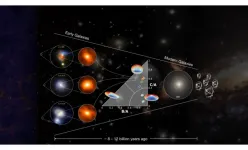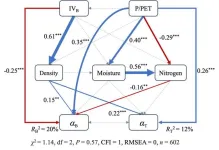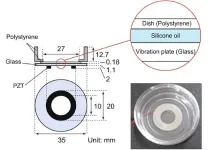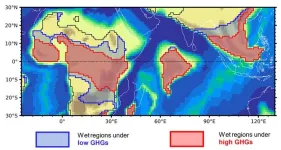(Press-News.org) An international team of researchers including The University of Tokyo Kavli Institute for the Physics and Mathematics of the Universe (Kavli IPMU, WPI) has found evidence showing that old elliptical galaxies in the universe can form from intense star formation within early galaxy cores. This discovery will deepen our understanding of how galaxies evolved from the early Universe, reports a new study in Nature.
Galaxies in today’s Universe are diverse in morphologies and can be roughly divided into two categories: younger, disk-like spiral galaxies, like our own Milky Way, that are still forming new stars; and older, elliptical galaxies, which are dominated by a central bulge, no longer forming stars and mostly lacking gas. These spheroidal galaxies contain very old stars, yet how they formed has remained a mystery—until now.
The discovery of the birth sites of giant, elliptical galaxies – announced in a paper published today in Nature – come from analyzing data from the Atacama Large Millimeter/submillimeter Array (ALMA) on over 100 Submillimeter Bright Galaxies (SMGs) with redshifts dating to the “Cosmic noon” era, when the universe was between around 1.6 and 5.9 billion years old and many galaxies were actively forming stars. This study provides the first solid observational evidence that spheroids can form directly through intense star formation within the cores of highly luminous starburst galaxies in the early Universe, based on a new perspective from the submillimeter band. This breakthrough will significantly impact models of galaxy evolution and deepen our understanding of how galaxies form and evolve across the Universe.
In this study, researchers led by Chinese Academy of Sciences Purple Mountain Observatory Associate Researcher Qinghua Tan, and including Kavli IPMU Professor John Silverman, Project Researcher Boris Kalita, and graduate student Zhaoxuan Liu, used statistical analysis of the surface brightness distribution of dust emission in the submillimeter band, combined with a novel analysis technique. They found that the submillimeter emission in most of sample galaxies are very compact, with surface brightness profiles deviating significantly from those of exponential disks. This suggests that the submillimeter emission typically comes from structures that are already spheroid-like. Further evidence for this spheroidal shape comes from a detailed analysis of galaxies’ 3D geometry. Modeling based on the skewed-high axis-ratio distribution shows that the ratio of the shortest to the longest of their three axes is, on average, half and increases with spatial compactness. This indicates that most of these highly star-forming galaxies are intrinsically spherical rather than disk-shaped. Supported by numerical simulations, this discovery has shown us that the main mechanism behind the formation of these tri-dimensional galaxies (spheroids) is the simultaneous action of cold gas accretion and galaxy interactions. This process is thought to have been quite common in the early Universe, during the period when most spheroids were forming. It could redefine how we understand galaxy formation.
This research was made possible thanks to the A3COSMOS and A3GOODSS archival projects, which enabled researchers to gather a large number of galaxies observed with a high enough signal-to-noise ratio for detailed analysis. Future exploration of the wealth of ALMA observations accumulated over the years, along with new submillimeter and millimeter observations with higher resolution and sensitivity, will allow us to systematically study the cold gas in galaxies. This will offer unprecedented insight into the distribution and kinematics of the raw materials fueling star formation. With the powerful capabilities of Euclid, the James Webb Space Telescope (JWST), and the China Space Station Telescope (CSST) to map the stellar components of galaxies, we will gain a more complete picture of early galaxy formation. Together, these insights will deepen our understanding of how the Universe as a whole has evolved over time.
END
Astronomers witness the in situ spheroid formation in distant submillimetre-bright galaxies
2024-12-05
ELSE PRESS RELEASES FROM THIS DATE:
Effects of bamboo invasion on forest structures and diameter–height allometries
2024-12-05
Bamboo invasion has been widely observed across Asia (e.g., China, Japan, and India), North America, South America (e.g., Brazil and Peru) and Africa. Moso bamboo (Phyllostachys edulis), a large-running bamboo species native to subtropical China, is known for its invasive nature and ability to encroach upon adjacent communities, particularly derived forests. While some plot-based studies exist, our understanding of how forest structural dynamics and diameter–height allometric relationships respond to bamboo invasion has remained limited.
In a study published in the KeAi journal Forest Ecosystems, researchers from China ...
Ultrasonication as a tool for directing cell growth and orientation
2024-12-05
Developing reliable methods to replace dead or damaged tissue is one of the primary goals of regenerative medicine. With steady advances in tissue engineering and biomedicine, we are almost at a point where growing cell sheets in the lab and transplanting them onto damaged or diseased organs is becoming a reality rather than fiction. Notably, myoblast cell sheets have already been used to successfully treat severe heart failure, demonstrating the potential of this technology.
However, there are still a few unsolved challenges ...
Lessons from Earth's hottest epoch in the last 65 million years: How global warming could shrink the tropics' rain belt
2024-12-05
Earth's tropical rain belt, responsible for monsoons that sustain billions of people and vibrant ecosystems, has long been a reliable feature of the planet's climate. But new research reveals this vital system wasn't always so dependable. A study published in Geophysical Research Letters shows that during the early Eocene—the hottest period in the last 65 million years—the rain belt's seasonal shifts weakened dramatically. These ancient changes could offer critical warnings about the impact of modern global warming.
A Greenhouse Climate 50 Million Years ...
Independent rice paddy methane model validated for global applications: Study highlights emission mitigation potential
2024-12-05
Rice paddies, responsible for approximately 10% of global anthropogenic methane (CH₄) emissions, are increasingly recognized as a key contributor to global warming. Reducing emissions from rice cultivation is essential to achieving international climate goals, especially in light of commitments to carbon neutrality and peak emissions targets.
A team led by Prof. LI Tingting from the Institute of Atmospheric Physics at the Chinese Academy of Sciences has validated an independently developed methane emission model, CH4MOD, at the global scale. This research highlights the advantages of process-based models over the commonly ...
Infertility linked to onset of systemic autoimmune rheumatic disease after childbirth
2024-12-05
Women who experience infertility but do not use fertility treatments have a higher risk of developing a group of conditions called systemic autoimmune rheumatic diseases (SARD) in the nine years after a naturally conceived birth compared to women without fertility problems.
The new research, published today (Thursday) in Human Reproduction [1], one of the world’s leading reproductive medicine journals, found that this was true even after accounting for higher rates of pre-eclampsia (high blood pressure during pregnancy), preterm birth ...
Researchers use data from citizen scientists to uncover the mysteries of a blue low-latitude aurora
2024-12-05
Colorful auroras appeared around Japan's Honshu and Hokkaido islands on May 11, 2024, sparked by an intense magnetic storm. Usually, auroras observed at low latitudes appear red due to the emission of oxygen atoms. But on this day, a salmon pink aurora was observed throughout the night, while an unusually tall, blue-dominant aurora appeared shortly before midnight.
Smartphone videos and amateur photos captured the event, enabling scientists to combine public data with their own research and study the phenomenon.
In a ...
Possible colon cancer vaccine target uncovered in bacteria
2024-12-05
Higher rates of certain cancers in countries, such as the UK, may be linked to two particular strains of bacteria. Targeting these with treatments or vaccines could help reduce the risk of colorectal, bladder, and prostate cancers.
Researchers from the Wellcome Sanger Institute, the University of Helsinki, and collaborators investigated the differences in cancer incidence for colorectal, bladder and prostate cancers, and compared these to global data tracking Escherichia coli (E.coli) strains. Specifically, they looked at the dominant two E.coli strains that produce a substance that has been previously identified as a risk factor for colorectal cancer.
Their ...
Eating dark chocolate linked with reduced risk of type 2 diabetes
2024-12-05
Embargoed for release: Wednesday, Dec. 4, 6:30 PM ET
Key points:
Study participants who consumed at least five servings of any chocolate per week showed a 10% lower risk of type 2 diabetes (T2D) compared to those who rarely or never ate chocolate. Dark chocolate had an even bigger impact: Participants who consumed at least five servings of this chocolate per week showed a 21% lower risk of T2D.
Consumption of milk chocolate, but not dark chocolate, was not associated with T2D risk; it was associated ...
Eating dark but not milk chocolate linked to reduced risk of type 2 diabetes
2024-12-05
Eating five servings of dark chocolate a week is associated with a reduction in the risk of type 2 diabetes, according to a long-term US study published by The BMJ today.
Global rates of type 2 diabetes are set to rise to 700 million by 2045. Chocolate contains high levels of flavanols (a natural compound found in fruits and vegetables) which have been shown to promote heart health and reduce the risk of type 2 diabetes. But the link between chocolate consumption and risk of type 2 diabetes remains controversial due to inconsistent results.
In addition, most previous studies have not looked at whether eating dark and milk chocolate – which have different ...
End food and drink industry’s infiltration of UK children’s education, say experts
2024-12-05
An investigation published by The BMJ today reveals widespread influence of food and drink brands in schools and nurseries – through breakfast clubs, nutrition guidance, and healthy eating campaigns - while rates of obesity in the UK have worsened.
Experts say the tactics are “subtle but very problematic” and require much greater scrutiny and pushback.
Organisations influencing food provision and education in schools include Kellogg’s, Greggs, Nestle, and the British Nutrition Foundation, a “policy development” charity ...





